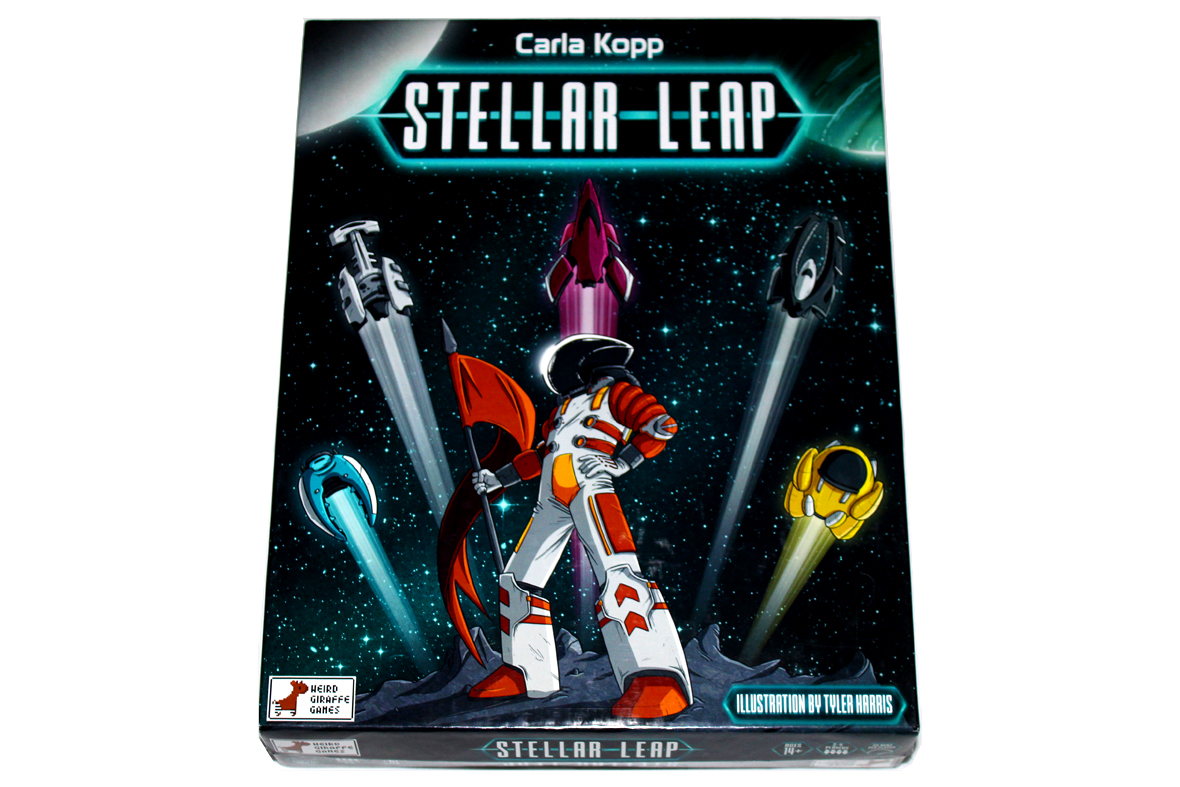
Base price: $39.
1 – 5 players.
Play time: ~20 minutes per player.
BGG Link
Check it out on Kickstarter!
Logged plays: 3
Full disclosure: A preview copy of Stellar Leap was provided by Weird Giraffe Games. Please keep in mind that some aspects of the game may change (as in art and gameplay), as this is a preview of an unreleased game.
Weird Giraffe Games is relatively new to the scene, dropping Super Hack Override a little while ago. Now, they move out of the retrofuture (but keep some of the neon, which is always a good choice) and head to space with Stellar Leap! Let’s check it out.
In Stellar Leap, you play as one of a variety of spacefaring civilizations destined to expand outwards past their home planets. You didn’t expect to find others, nor did you really expect it to get so … crowded. Thankfully, there are solar systems yet undiscovered and hyperspace jumps and all sorts of fun things to do. Will you be able to extend your reach to the stars above?
Contents
Setup
So, first thing’s first, give every player a player board:

Personally, I prefer the birds (Space Birbs, is generally what I call them), but you do you. There should also be chits associated with each player:

And home worlds:
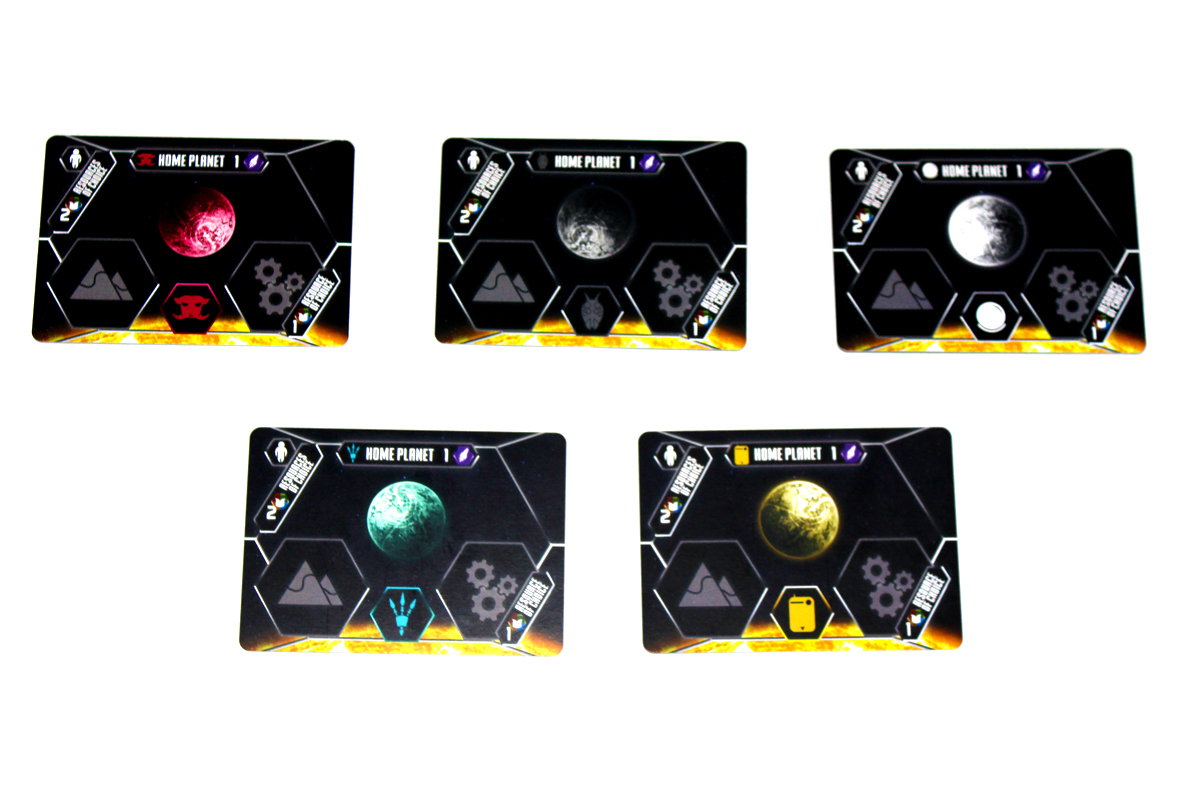
Everyone should take those. Every player has meeples and some blocks in their color:
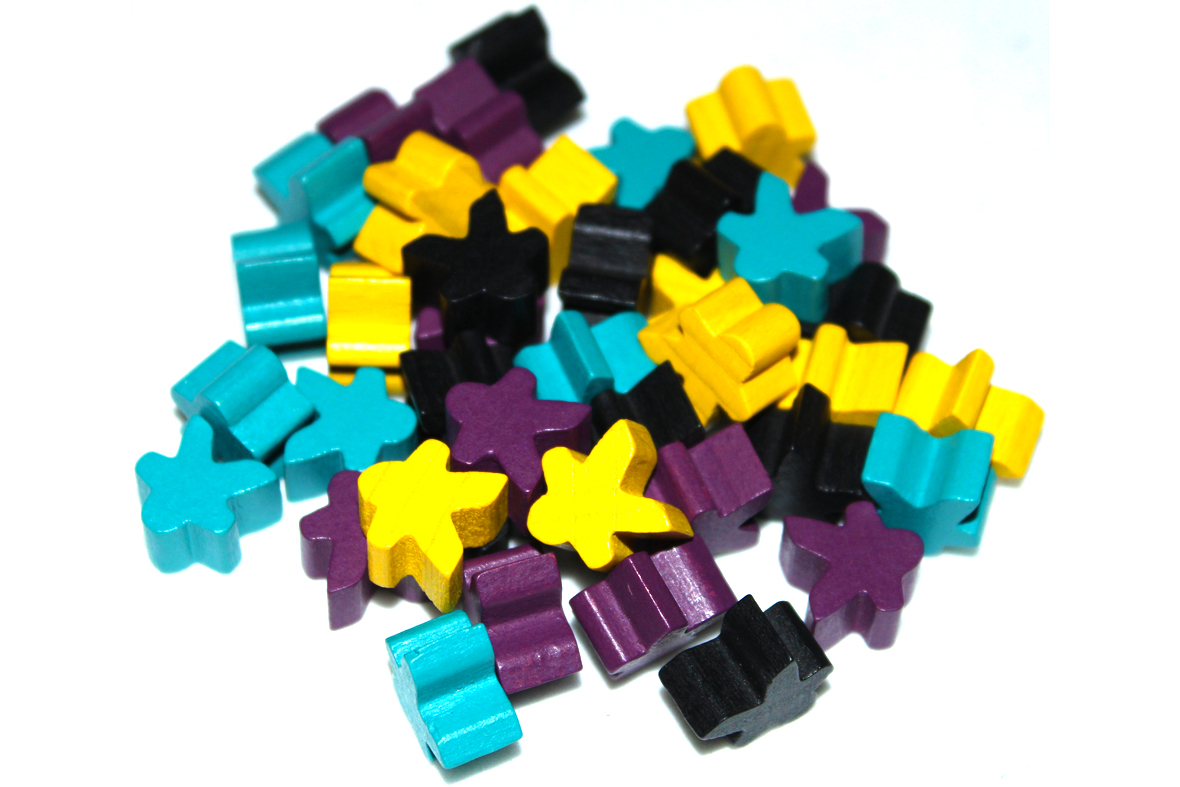
Put the 10 meeples on the 10 Population spaces along the bottom of your player board, put the four cubes in different colors on the “3” in the Cargo Hold, and add the 5 cubes in your player color to the checked spaces that represent actions.
Now, set the dice cards out from 1 – 6 to create sort of the play area:
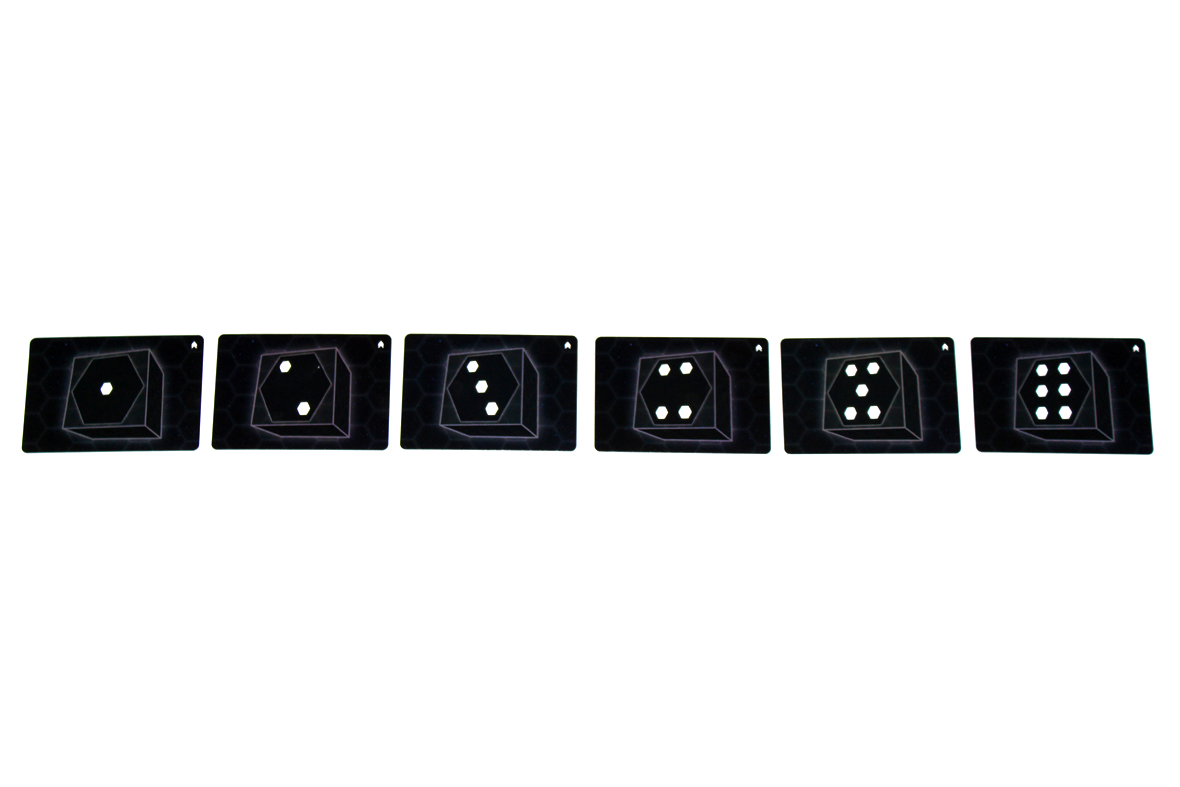
You’ll add planets below that as you play. It’ll be great.
There are two types of planets. Safe Planets come first, so shuffle those:
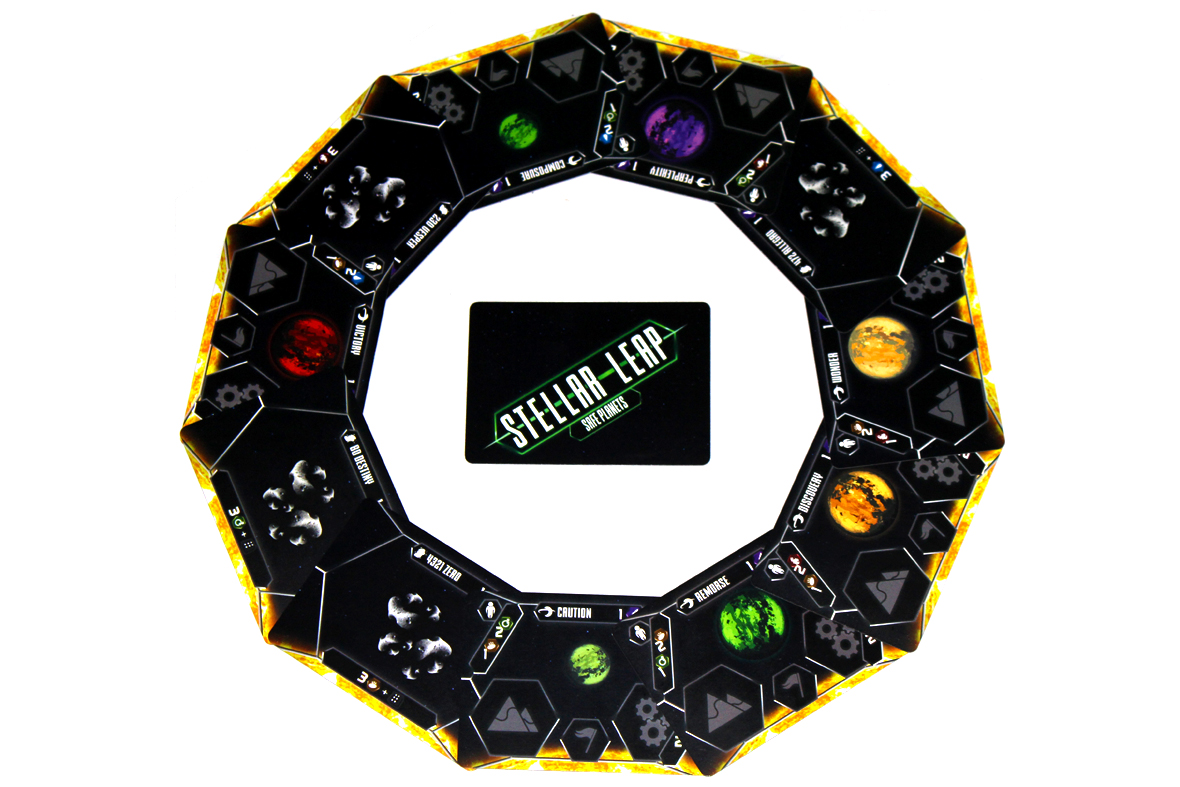
Next up are Dangerous Planets:
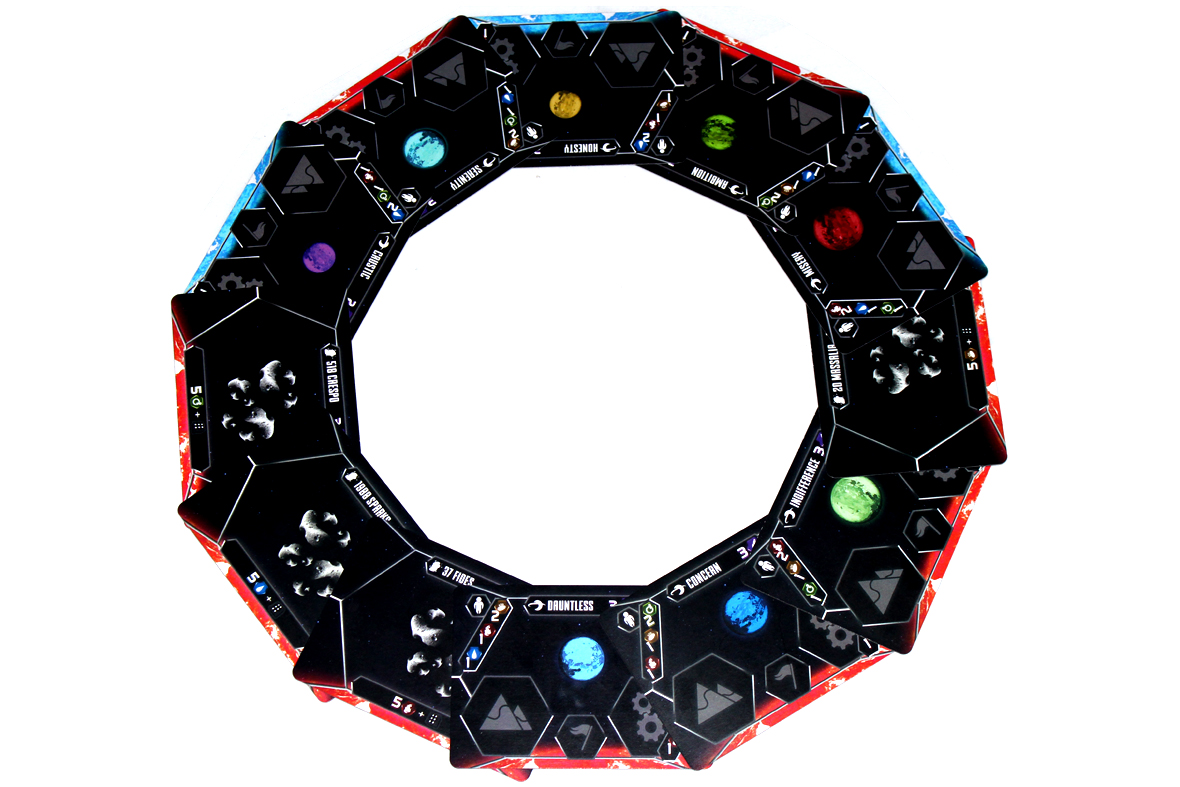
Shuffle the two piles but keep them separate. Shuffle up the Events as well, but keep them near the World cards:

What else is there? Well, there are three tiers of Mission cards:
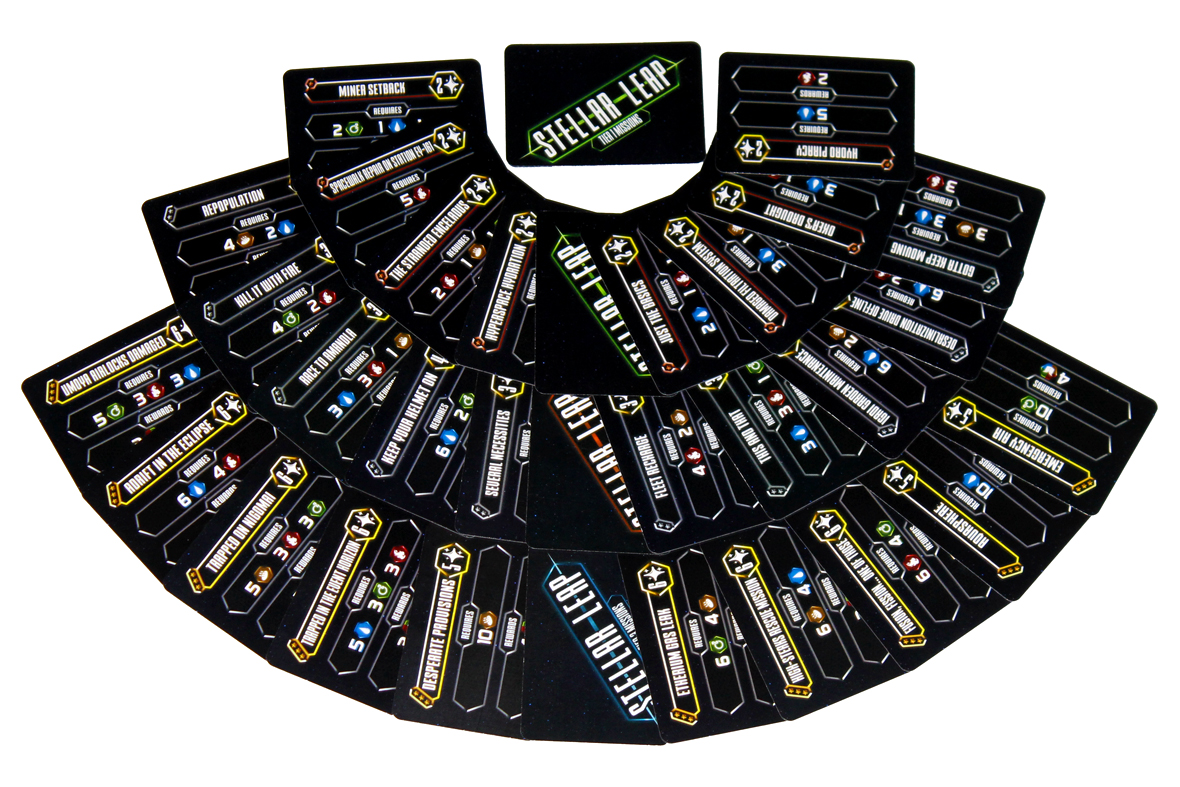
Use all the Tier 3 Missions, and also use 2 Tier 1 and Tier 2 Missions per player. You’ll want to set out four Tier 1 Missions near the tableau / play area so that all players can see them.
Set the dice aside for now:

Every player should also get two Traits:
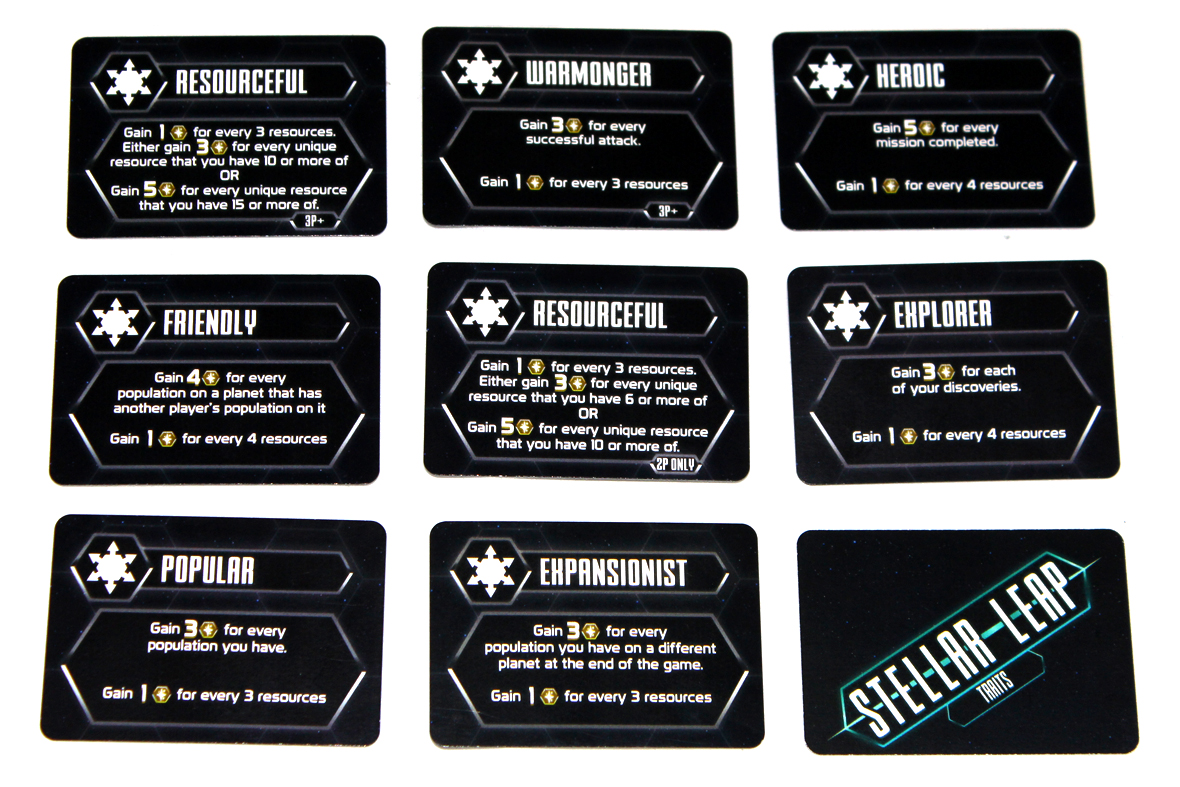
They should also get two Player Dice Powers:
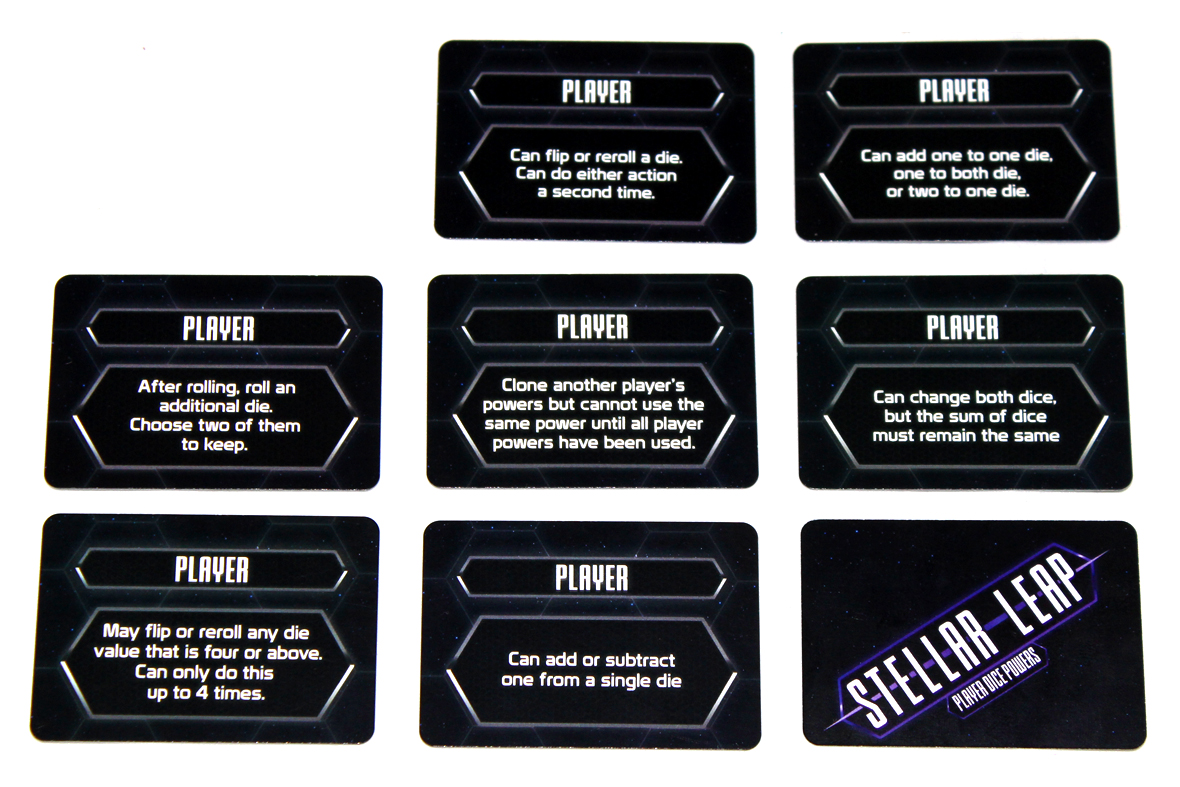
They keep one and discard the other to the box for each set. Add one Community Dice Power:

And then you’re about ready! You can handle the last bit of setup in one of two ways:
- Each player in turn order takes their Home World and places it in a column of their choice, as close to the dice card as possible. This means if two players both place in column 3, there will be a planet in the first and second row.
- Each player in turn order rolls a dice and places their planet in that column. I think this prevents a bit of bias, but you do you. Plus I like the random nature of it.
Either way, once you’ve done that you’re ready to start!
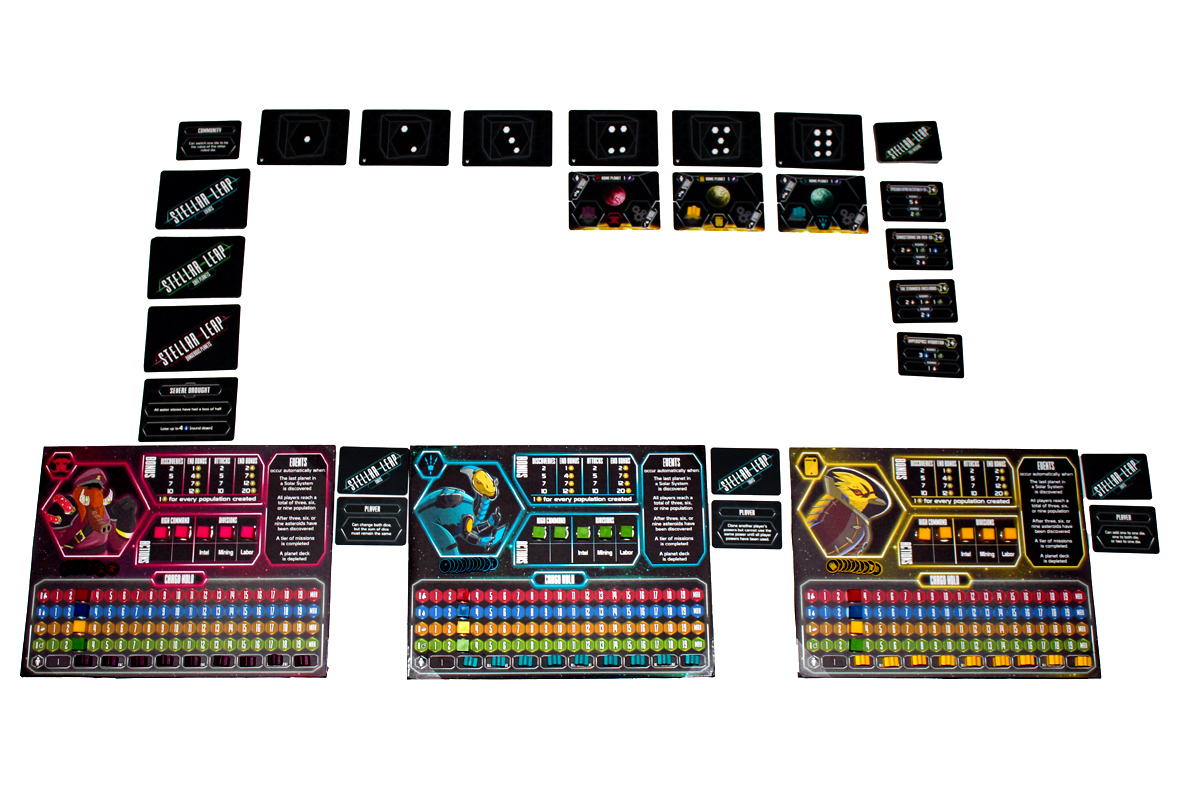
Gameplay
Alright, so, the game takes place over a series of turns, ending when six Events are drawn. Once the sixth Event is drawn, finish the current round so every player has taken the same number of turns. But how’s a turn work?
- Recover population.
- Roll dice to collect resources.
- Perform actions.
Let’s take that in order.
Recover Population
This one’s super easy. If any of your Population are exhausted (from Labor or retreating), put them back on the left side of the card to indicate that they’re not exhausted and can move / collect resources again.
Roll Dice
This is actually a few steps. First off, you’ll roll the two big dice.
Next, you can apply either the Community Dice Power or your personal Dice Power to manipulate the dice. Some dice powers allow you to “flip” a die. Like Sagrada, that means to turn it physically over so that it’s on the other side. The easiest way to remember this is that the two sides sum to 7, so, 6 + 1; 5 + 2; and 4 + 3. That’s how I keep it straight, anyways.
Once you’ve done that (or not), you check the dice faces. Each planet in a column matching either dice face or the sum of the faces generates resources. If you have a meeple there, you collect those resources, even if it’s not your turn. If every player has at least one population on that planet (or 3 out of 4 in a 4-player game), it’s considered overpopulated and generates fewer resources (see the top right corner).
There’s some strategy here to making sure your opponents don’t get too many resources from your rolls, so be careful!
Actions
There are a BUNCH of actions you can take, but there’s always one you should consider:
Movement
At any point on your turn, you may, as a free action, move X population by spending X Oxygen and Y fuel, where Y is the Threat Level of the planet you want to move that population to + the number of rows (not columns, rows) away it is. So if you’re moving five population to a Dangerous World that’s threat level 3 and it’s a row below your planet (column doesn’t matter; it’s all the same solar system), it’ll cost 5 oxygen and 4 fuel. You can do this any time, as many times per turn as you’d like.
The other actions are as follows:
High Command Actions
These are sort-of generic actions. You can take two of these per turn.
- Populate: Spend two food and one water to add a meeple from your player board to a planet where you already have a meeple. If you uncover an ALL PLAYER EVENT, that event triggers if all players have placed their third meeple, sixth meeple, or ninth meeple.
- Discover: You can draw two Planet cards (Dangerous or Safe) and place one in the play area. Always put the planet as close to the dice card as possible in a given column. Return the other to the bottom of its deck. If you draw an asteroid, put a die on it with the “3” up.
- If you complete a row, trigger an Event.
- If you deplete a Planet deck, trigger an Event.
- If you place the third, sixth, or ninth asteroid, trigger an event.
- Tax: Gain two resources of your choice. It’s not much more exciting than that, but it’s usually helpful.
- Attack: For this event, if you have the majority of population on a planet (strictly more than everyone else combined), then you can boot them all off! Other players’ exhausted population does count towards this total, but yours does not. If you attack successfully, all other population must retreat (for free) to other planets with their population. When they do, they also become exhausted. You then get a chit from every player whose population you ejected to symbolize your victory (and for points!). If you don’t have enough population to attack, don’t forget, you can move as a free action and then attack.
Division Actions
These are division-specific, and they are the three actions on the right side of the action area. You may activate each division once per turn.
- Intel: If you have enough resources to pay for one of the Missions (the required resources are pictured on the card), you may spend it and take the corresponding Mission card. You then get the resources listed under the rewards section. You can only take one Mission per turn.
- If you complete a Tier of Missions (for instance, every Tier 1 or Tier 2 Mission), you trigger an Event.
- Mining: You may move one population to an asteroid card (normal movement rules apply) and roll the number of dice pictured on the die on the asteroid. You get the number of resources pictured on the asteroid plus the highest die you rolled. So if you rolled a 3, and 5, and a 1 on a 3 Oxygen asteroid, you’d get 8 (3 + 5, your highest roll) Oxygen. You then decrease the die by 1 (remove it if it’s already at 1) and return back to your original planet for free. Mining!
- Labor: You may exhaust one population on a planet to gain that planet’s Labor yield (bottom right corner) resources. Note that they don’t un-exhaust until the start of your next turn, so you might miss out on collecting resources!
Game End
Play continues until six Events have been resolved, as mentioned previously. That said, that’s flexible, so you can increase or decrease that if you want a longer / shorter game, respectively. Once that’s happened, make sure everyone gets the same number of turns (Splendor style), and then tally points.
The player with the most points wins!
Player Count Differences
I think that, for me, the major one is attacking. At lower player counts you might be able to attack more easily, but the yield is so much lower since you’ll get at least one player chit per attack (and, indeed, at most). At four or five players you could potentially get four player chits per attack, though you’ll also need a MUCH larger population to make use of that.
Other than that, I think the game is pretty interesting no matter what player count you play it at! At lower player counts you’ll see more population out and around (since each player has to do more to end the game, typically), whereas at higher player counts the game will end a bit earlier before any player has time to dig in as deep as they can in the two-player game. I don’t really have a strong preference, here.
Strategy
- Focus on your trait. It’s going to get you at least half of your points (hopefully), so do what it tells you to do.
- You should also try to get lots of resources. That’s generally advisable, since resources are worth a bunch of points towards the end of the game. The more points you have, the more likely it is you’ll win!
- Try not to incentivize other players attacking you. This might mean that you move two meeples to a planet at a time so that they have to move three to attack successfully, but whatever works. You might be able to just remind them that attacking consumes an action that they might otherwise want to spend on something else.
- Doing a surprise move to end the game can sometimes be effective. It means that nobody expected you to pull two events in one turn and end the game, so they might have set up a combo that you’re now invalidating, which is always nice.
- Another nice way to avoid attacks is to just only Discover planets within a column. It means you’re SUPER far away from other players, but they’re far away from you as well, so it’s maybe not worth it to chase you down.
- You can also kind of invalidate attacking as a strategy by just never moving onto a planet with another player. It means that the attacker gets one chit MAX from attacking you, which … isn’t generally super worth it?
- I would recommend Discovering planets towards the higher side of the dice. You’re equally likely to roll any one number, but there are a lot more dice combinations that sum to 6 than there are that sum to 1. This means you might get the benefit of the sum a lot more frequently, which is super nice. I kind of tend to stay away from the 1s.
- Try to do a Mission every turn, if you can. You have an action for it, and it’s free points if you can make it work.
- Asteroid mining is usually pretty useful, for the same reasons. You have an action for it, and you can get a lot of resources if you’re lucky.
- Labor, meh, it’s situational. If you have two meeples on a planet, labor on that planet! The nonexhausted one will still collect. Otherwise, you run the risk of getting that planet rolled and missing out on resources. It really depends on how much you need that labor resource in the moment, but, yeah.
- I find that many players just Discover + Populate on their turn until they run out of population. It’s a great way to continually gain a few points every turn, so, more power to you. Plus you can build really intricate solar systems.
- It might be worth taking a lower tier Mission in order to get an Event. Especially if that Event pushes the game towards its conclusion.
Pros, Mehs, and Cons
Pros
- The mission card names are pretty cool. They must have gotten someone pretty great to come up with a bunch of those.
- The game has a nice sense of spatial accomplishment. I like looking at the tableau after the game’s ended and seeing how much of a galaxy we created. It’s really cool!
- Supports a wide variety of playstyles. I always appreciate a game with multiple paths to victory and each seems pretty solid. You can take the more expansive approach and discover a lot of stuff, you can be aggressive and fight other players, or you can focus on resource collecting and missions. You should make sure to focus on your trait, but it means each playthrough might be pretty different as you approach the game differently.
- The dice manipulation powers are a nice way to mitigate the luck factor of dice rolling. I think you can get strictly “good” rolls, but it’s very tough to get a roll (especially mid- to late-game) that’s “bad”.
- Good sense of advancement and progression. When you move through the game you feel yourself gathering more resources and being able to buy better things and advance more, even if you’re not in first place. It’s a nice thing for the player.
- The various player races are great. Space Birbs for life, personally.
- I like the ability to gain resources on other players’ turns. Dice Forge has this too and I really like it as an aesthetic.
- Seems expandable. I could see other races, traits, resources, planets, and other things making their way into an expansion. Maybe take a cue from Tiny Epic Galaxies: Beyond the Black and add special kinds of spaceships?
Mehs
- It’s very black, graphically speaking. It makes it hard to photograph, so I’ll whine a bit about it, here. Oh well, this is why I own a white backdrop as well.
- The player boards are pretty busy. Take a deep breath and it will all make sense, but if this is your first foray into strategy games it might stress you out a bit. I kind of recommend with new players explaining the rules and then showing them the player boards.
- Some of the player traits seem a bit strictly better or worse than others. I’m filing this as a Meh because I’ve already given this feedback and it sounds like something that’s being tweaked a bit, still. If it’s still in the full game I may downgrade this to a Con. It’s not enough to make the game bad in any way, there are just a couple powers that I avoid or encourage other players to avoid.
- Tiny cards are the bane of my existence. It happens.
Cons
- It can take up a weird amount of space, spatially. Insert space game pun, but if you’re going after a certain strategy of avoidance, you can have a column extend pretty deep into space, after a certain point. That can be annoying on your table and kind of violates the utility of a playmat.
- A few things seem vaguely confusing from a theme standpoint. I understand from a game design standpoint why, say, you can only grab one mission or Labor with one planet per turn, but thematically it kind of strikes me as odd. Or why the number of asteroids discovered triggers an Event. It’s a bit jarring. Not enough to impact my enjoyment of the game, but it’s a bit confusing.
Overall: 7.75 / 10
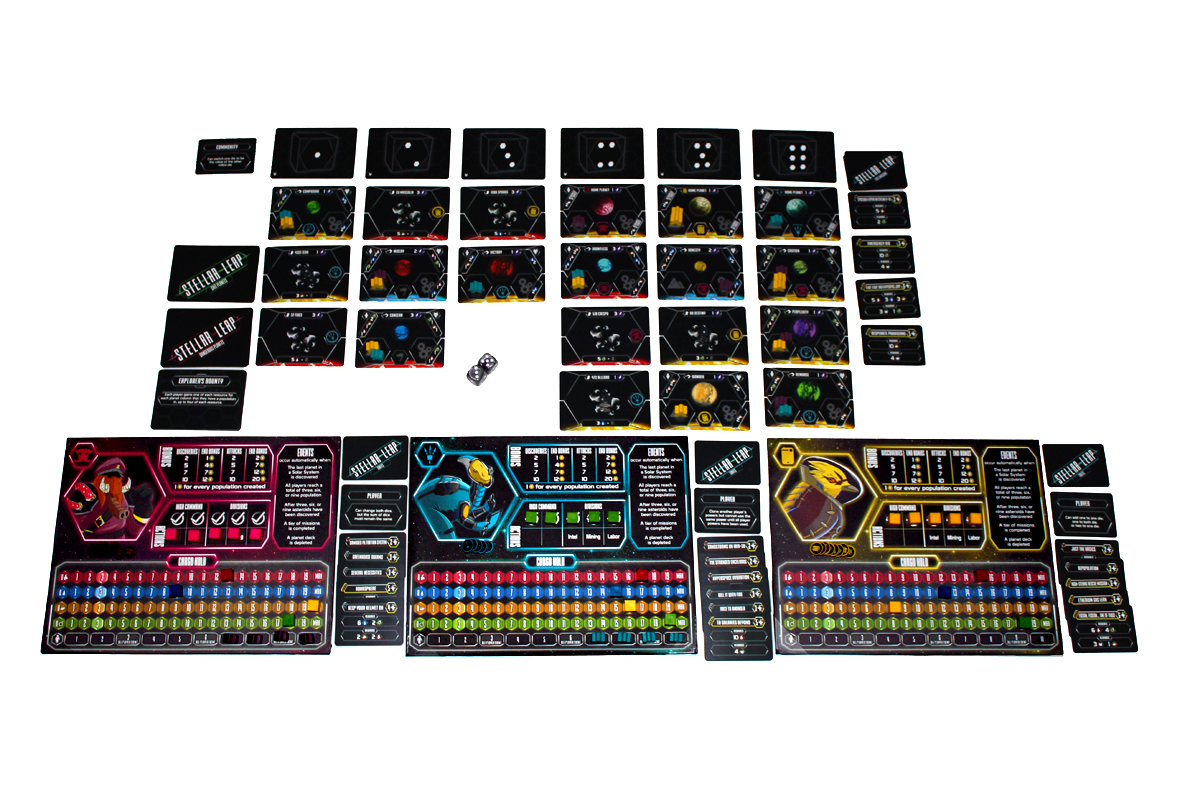
Overall, I’m a fan of Stellar Leap! I think it’s a solid … is it a 4X game? It kind of seems like it. I’m not an expert with these things. Either way, if it is, it’s a great introduction to the genre. If it’s not, it’s a solid intro-ish (maybe one step past gateway?) space game for the entire family, honestly. Everyone has things that they can do that mesh with their personal play style, nobody has to get too into anyone’s business, and it’s a slick concept. I could see similar games with the same kind of general schtick popping up with, like, a Deep Sea Adventure theme because the game system is pretty solid. I, for one, look forward to seeing what stretch goals this Kickstarter hits, and would recommend checking it out.
One thought on “#128 – Stellar Leap [Preview]”